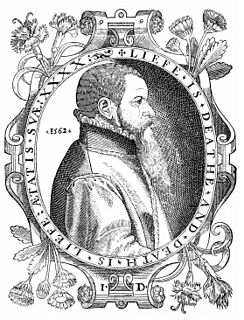Related Research Articles

John Foxe, an English historian and martyrologist, was the author of Actes and Monuments, telling of Christian martyrs throughout Western history, but particularly the sufferings of English Protestants and proto-Protestants from the 14th century and in the reign of Mary I. Widely owned and read by English Puritans, the book helped to mould British opinion about the Catholic Church for several centuries.

John Day was an English Protestant printer. He specialised in printing and distributing Protestant literature and pamphlets, and produced many small-format religious books, such as ABCs, sermons, and translations of psalms. He found fame, however, as the publisher of John Foxe's Actes and Monuments, also known as the Book of Martyrs, the largest and most technologically accomplished book printed in sixteenth-century England.
John Marbeck, Merbeck or Merbecke was an English theological writer and musician who produced a standard setting of the Anglican liturgy. He is also known today for his setting of the Mass, Missa Per arma justitiae.

John Bradford (1510–1555) was an English Reformer, prebendary of St. Paul's, and martyr. He was imprisoned in the Tower of London for alleged crimes against Mary Tudor. He was burned at the stake on 1 July 1555.

Shottesbrooke is a village and civil parish administered by the unitary authority of the Royal Borough of Windsor and Maidenhead in the English county of Berkshire. The village is mostly rural: 88% covered by agriculture or woodland and had a population of 141 at the 2011 census.
John Capon, aliasJohn Salcot was a Benedictine monk who became bishop of Bangor, then bishop of Salisbury under Henry VIII. He is often referred to as John Salcot alias Capon.
William Blackall Simonds (1761–1834) was a brewer and banker in the English town of Reading. He founded both Simonds' Brewery, a component of today's Wells & Young's Brewery business, and J & C Simonds Bank, one of the precursors to Barclays bank.
Robert Testwood of London was an English Protestant martyr during the reign of Henry VIII, one of the Windsor Martyrs.
Adam Damlip, also known as George Bucker, was an English Protestant martyr during the reign of Henry VIII.

Thomas Benet from Cambridge, was an English Protestant martyr during the reign of King Henry VIII. In 1524, he moved to Torrington, North Devon, with his wife and family so that he could exercise his religious conscience more freely in a county where no one knew him. He was executed by burning on 15 January 1531, for heresy, at Livery Dole outside Exeter in Devon, under the supervision of Sir Thomas Dennis (c.1477-1561) of Holcombe Burnell, near Exeter, then Sheriff of Devon.

The Colchester Martyrs were 16th-century English Protestant martyrs. They were executed for heresy in Colchester, Essex, during the reigns of Henry VIII and Mary I. Their story is recorded in Foxe's Book of Martyrs.
The Canterbury Martyrs were 16th-century English Protestant martyrs. They were executed for heresy in Canterbury, Kent, and were the last protestants burnt during the reign of Mary I. Their story is recorded in Foxe's Book of Martyrs.
The Windsor Martyrs were English Protestants martyred at Windsor in 1543. Their names were Robert Testwood, Anthony Pearson and Henry Filmer.
Henry Filmer was a 16th-century English Protestant martyr, one of the Windsor Martyrs, during the reign of Henry VIII.
Robert Benet was the Mayor of Windsor, England in 1536.
The Perth Martyrs were six people executed in Perth, Scotland in 1543 for their Protestant beliefs. The condemned people were William Anderson, James Finlayson, James Hunter, Robert Lamb, James Raveleson and Helen Stark. They were sentenced to death for their beliefs, after being convicted by the Archbishop of St Andrews. Anderson, Finlayson, Hunter and Lamb were sentenced to be hanged, Raveleson was to be burnt; and Helen Stark, "with her sucking infant", was to be put into a sack and drowned. Their story is recorded in Foxe's Book of Martyrs, in Calderwood's History of the Kirk of Scotland and in James Anthony Froude's History of England.

The Actes and Monuments, popularly known as Foxe's Book of Martyrs, is a work of Protestant history and martyrology by Protestant English historian John Foxe, first published in 1563 by John Day. It includes a polemical account of the sufferings of Protestants under the Catholic Church, with particular emphasis on England and Scotland. The book was highly influential in those countries and helped shape lasting popular notions of Catholicism there. The book went through four editions in Foxe's lifetime and a number of later editions and abridgements, including some that specifically reduced the text to a Book of Martyrs.
John London, DCL was Warden of New College, Oxford, and a prominent figure in the Dissolution of the Monasteries during the reign of Henry VIII of England.
Cornelius Bongey was an English Protestant martyr who was burnt at Coventry in September 1555.
References
- 1 2 Ford, David Nash (2009). Berkshire in the Reign of Henry VIII. Wokingham: Nash Ford Publishing.
- ↑ p.172-176, Testwood and his companions, John Foxe, Foxe's Book of Martyrs , 2000, Ambassador Publications